Let me admit it: I made my first email marketing funnel 15-20 years ago, and it was a disaster.
I felt so excited when I launched it. I had put together what I thought was a great offer, and I was sure that people would love it.
But they didn't. Instead, my open rates tanked and my unsubscribe rate soared. I tried to sell too many things at once and my list quickly became overwhelmed.
It was a hard lesson to learn, but I eventually realized that less is more when it comes to email marketing. Now, I focus on creating a simple but effective email marketing funnel to sell just one thing.
And you know what?
It works like a charm!
Recently, I got an open rate of 26.5% for a newsletter that I sent to my subscribers. I’ve reached this stage after a lot of hits and misses.
Over the years, I’ve learned some important lessons and I want to share them with you. I’d like your first email marketing funnel to be better than mine!
In this post, I am going to start with the basics and then move on to discuss how to create a solid email marketing funnel for your business.
What is an Email Marketing Funnel?
An email marketing funnel is a process that uses email marketing to draw prospective customers through a series of stages, from awareness to purchase. The goal of an email marketing funnel is to build relationships with potential customers and turn them into paying customers.
The email marketing funnel is a variation of the sales funnel. It is specifically designed to generate leads and build relationships with potential customers by tapping into the power of email marketing.
Why Does Your Business Need an Email Marketing Funnel?
If you're like most business owners or marketers, you know that email marketing is a powerful tool to reach your customers and grow your business.
Here’s some proof:
- Email marketing is projected to be worth 17.9 billion US dollars by 2027.
- Unilaterally, subscribers around the world agree that they would respond favorably to an email that had personalized content.
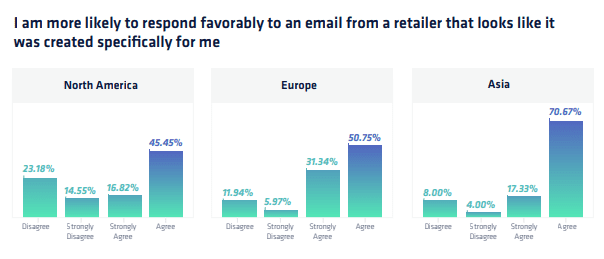
- For every $1 spent, effective email marketing campaigns can generate an ROI of a whopping $36.
These numbers already show that emails can be a potent marketing weapon. But how do you ensure that you can build an effective email campaign?
That’s where your email marketing funnels come in.
They can help you maximize the impact of your email campaigns and get the most out of your list. And from my experience, I can you tell that it’s really important. It can be the major difference between having a winning email marketing strategy and a lukewarm one.
Here's exactly how an email marketing funnel can help you grow your business:
1. An email marketing funnel allows you to segment your list and target your messages.
When you have a large list of subscribers, it can be difficult to know which message to send to whom. With an email marketing funnel, you can segment your list into smaller groups and target your messages accordingly.
This ensures that your subscribers get the most relevant and targeted messages, which leads to better engagement and conversions.
2. An email marketing funnel allows you to automate your email campaigns.
With an email marketing funnel, you can set up automated email campaigns that send out pre-written messages to your subscribers at specific intervals.
This takes a lot of the guesswork and manual work out of email marketing and allows you to focus on other aspects of your business.
3. An email marketing funnel allows you to track and analyze your results.
With an email marketing funnel, you can track how many people receive and open your emails, click on your links, and convert into customers. This data is invaluable in understanding what works and what doesn't in your email marketing campaigns. And it allows you to make the necessary adjustments needed to improve your results.
If you're not using an email marketing funnel in your business, now is the time to start.
Implementing an email marketing funnel can help you segment your list, automate your email campaigns, and track and analyze your results. Ultimately, this can lead to more customers and sales for your business.
What Are the Different Stages Within the Email Marketing Funnel?
The simplest way to think about an email marketing funnel is this: It's a series of emails that helps convert a stranger into a customer.
Each email in the funnel has a specific purpose and moves the prospect closer to becoming a paying customer. If you already know the different stages of a generic marketing funnel, it’ll be super easy for you to relate this concept to email marketing.
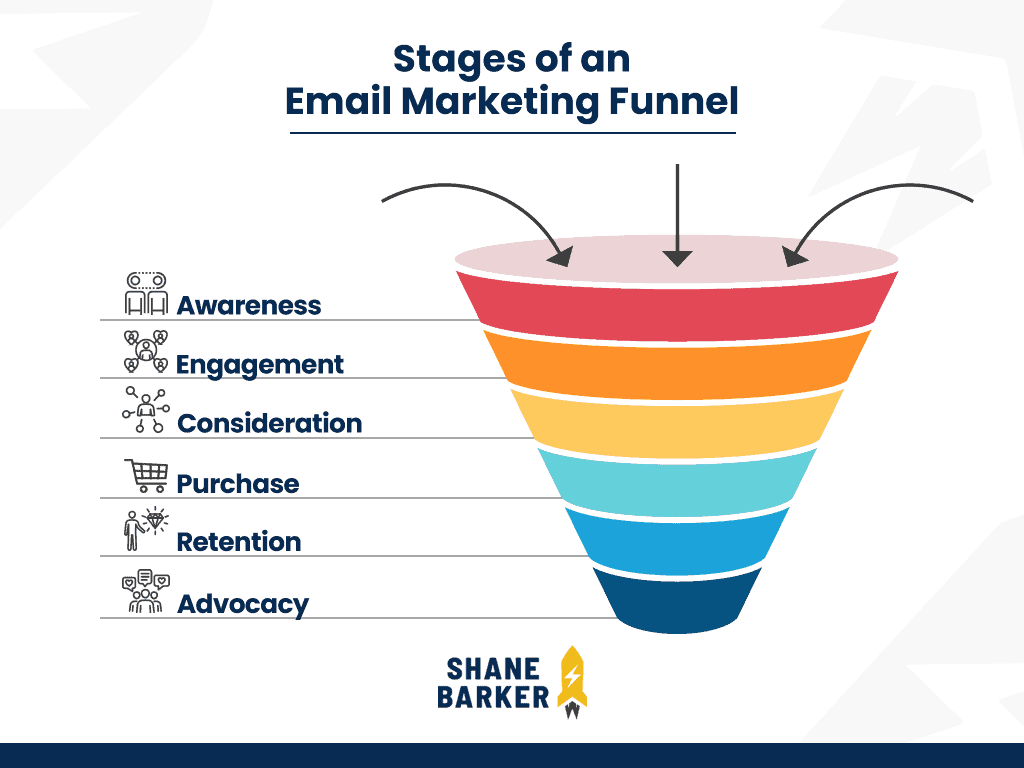
Ideally, your email marketing funnel will take a person who has never heard of your business and turn them into a lifelong customer. In this section, let’s take a closer look at all the stages of an email marketing funnel.
The email funnel has five different stages: Engagement, Discovery, Purchase, and Retention.
1. Awareness
The first stage of the email marketing funnel is Awareness. This is when potential customers start to develop an interest in your products or services. They become aware of your existence and what you have to offer.
Awareness-stage content should help your audience learn more about their problem or challenge and how your product or service can help them solve it.
When crafting your awareness-stage email content, remember to:
- Keep it educational and informative.
- Address your audience's challenges directly.
- Use strong headlines and calls-to-action.
- Keep your content focused on your reader, not on you or your product.
2. Engagement
The second stage of the email marketing funnel is Engagement. This is when potential customers start interacting with your brand, usually through subscribing to your email list or visiting your website.
It's the stage where you build relationships with your subscribers and keep them asking for more. The best way to do this is by providing valuable content that they can't find anywhere else.
This could be in the form of welcome emails, helpful tips, live polls, or behind-the-scenes access to your business.
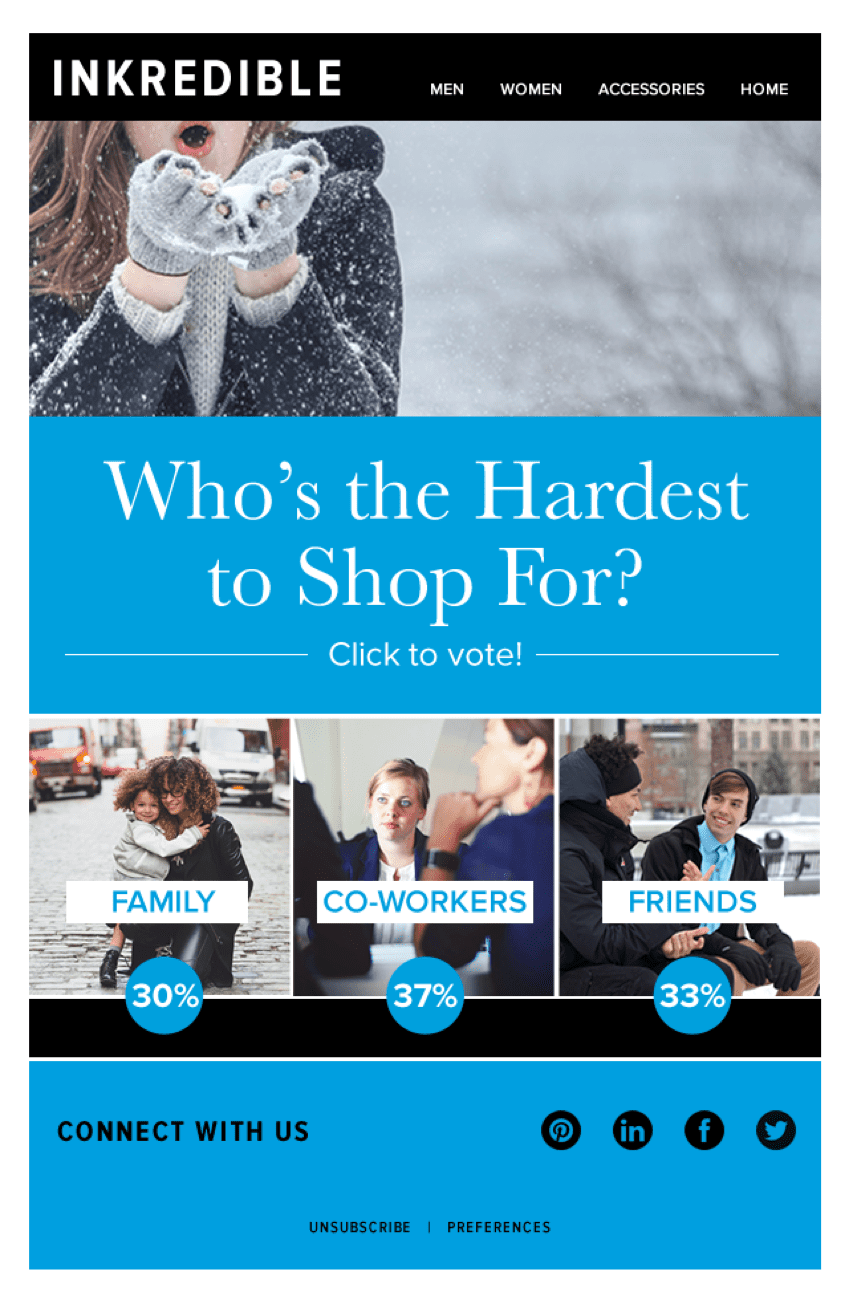
Make sure to keep your content fresh and engaging so that your subscribers always have something to look forward to in your emails. Engagement is the key to success in email marketing!
3. Consideration
The third stage of the email marketing funnel is Consideration. This is when potential customers start to compare your products or services to those of your competitors and decide whether or not to make a purchase.
If you're looking to get the most out of your email marketing campaigns, it's important to consider how you can use content to appeal to your audience during the consideration stage of their buyer's journey.
At this stage, potential customers are beginning to evaluate their options and narrow down their choices. They're looking for more information about the products or services they're interested in and are starting to compare different options.
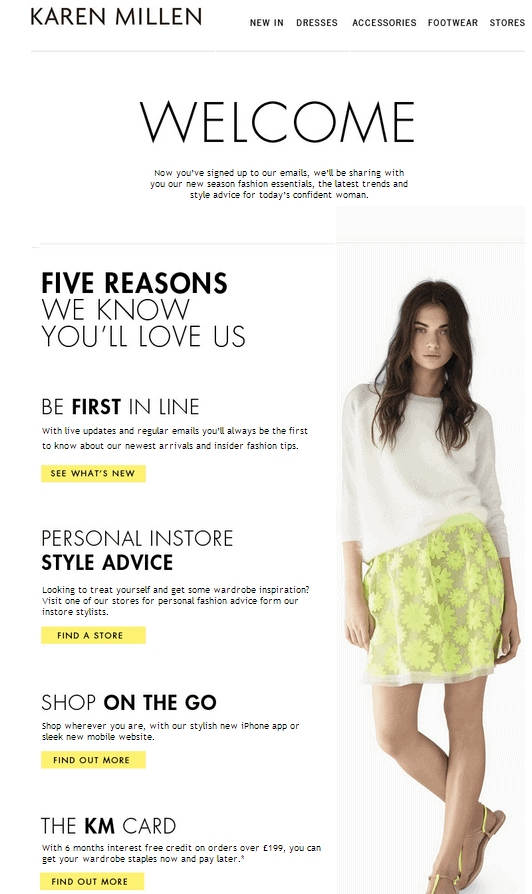
This is where your email content can come in handy. By providing potential customers with valuable information about your product or service, you can help them make a more informed decision about whether or not it's the right fit for them.
Here are a few tips for creating email content that will appeal to your audience during the consideration stage:
- Provide an overview of your product or service: Give potential customers a brief overview of what you offer and what makes it unique.
- Offer comparisons: If you're competing against other products or services, provide a side-by-side comparison of how your offering stacks up.
- Share customer testimonials: Customer testimonials can be incredibly powerful at this stage, as they provide first-hand accounts of how your product or service has helped others.
- Describe the benefits: Be sure to highlight the main benefits of your product or service so potential customers can see how it can help them.
4. Purchase
The purchase stage of the email marketing funnel is when your subscribers are ready to buy what you're selling. At this stage, it's important to provide them with content that will help them make a buying decision.
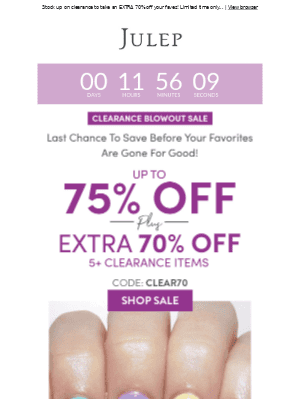
This could include things like product reviews, buyer's guides, coupon codes, and other types of content that will help them finalize their purchase. By providing helpful content at this stage, you can increase the chances that your subscribers will buy from you.
5. Retention
Retention is the stage of the email marketing conversion funnel where you work to keep your subscribers engaged with your brand. This is done by creating content that is relevant and interesting to them.
Content for the retention stage should be focused on providing value and maintaining strong relationships with your subscribers.
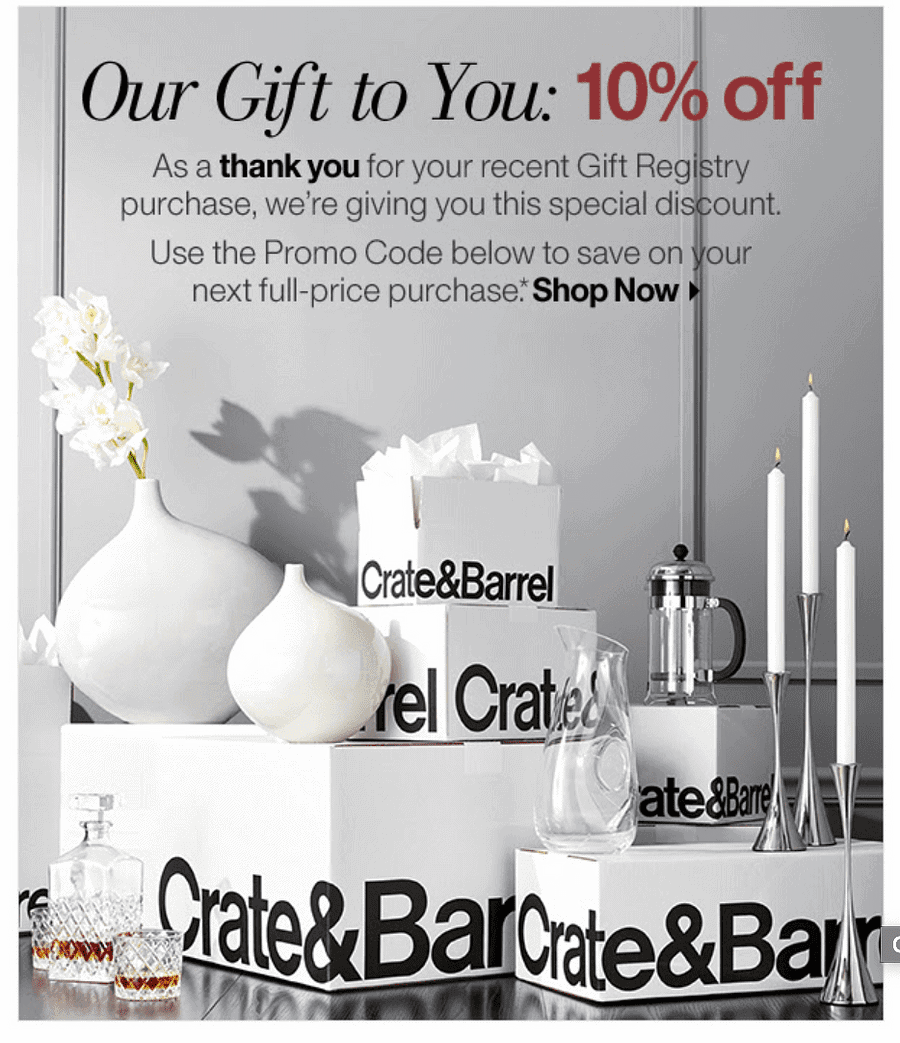
It can include things like loyalty discounts, exclusive deals, or early access to products. Whatever you choose to include, make sure it's something your subscribers will appreciate and find useful.
By creating quality content for the retention stage of your email marketing funnel, you can keep your subscribers engaged and interested in what you have to offer. This, in turn, will help increase loyalty and conversions.
6. Advocacy
Advocacy is the stage of the email marketing funnel when your subscribers are actively promoting your brand to their networks.
This is typically done through word-of-mouth, but can also be accomplished by sharing your emails or other content on social media, writing reviews, or even just telling their friends and family about your business.
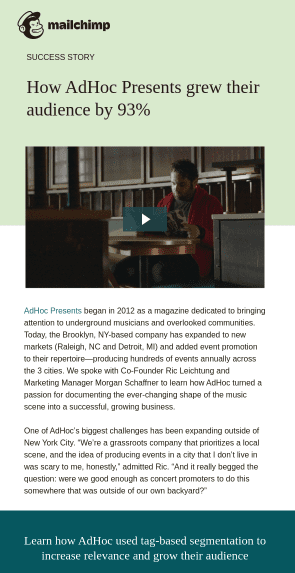
To create content for this stage of the funnel, you'll want to focus on creating pieces that will inspire your subscribers to share. This could be anything from a detailed case study or review of your product to an interesting blog post or infographic.
Whatever you create, make sure it's something that your subscribers will find valuable and worth sharing with their networks.
Elements of an Effective Email Marketing Funnel
When it comes to email marketing, there's no one-size-fits-all approach. The strength of your email marketing funnel will depend on your specific goals and audience.
However, there are some key elements that should guide how you build your marketing funnel strategy, including:
1. Clarity of Purpose
First and foremost, a strong email marketing funnel must have a clear purpose. Every email in your funnel should be working towards achieving a specific goal, whether that's generating leads, building brand awareness, or making sales.
Without a clear purpose, your emails will lack direction and focus, and your recipients won't know what action you want them to take.
Knowing your goals will help you understand what you want to achieve with your email marketing campaign. Based on that, you can determine what kind of content to include in your emails and how to structure your funnel sequence.
2. Precise Targeting
Your email marketing funnel should also be highly targeted. Every step of the funnel should be designed with a specific segment of your audience in mind. This ensures that your messages are relevant and engaging and that recipients are more likely to take the desired action.
Here is an example of how Sephora uses email targeting to retain their customers based on what they’ve ordered before:
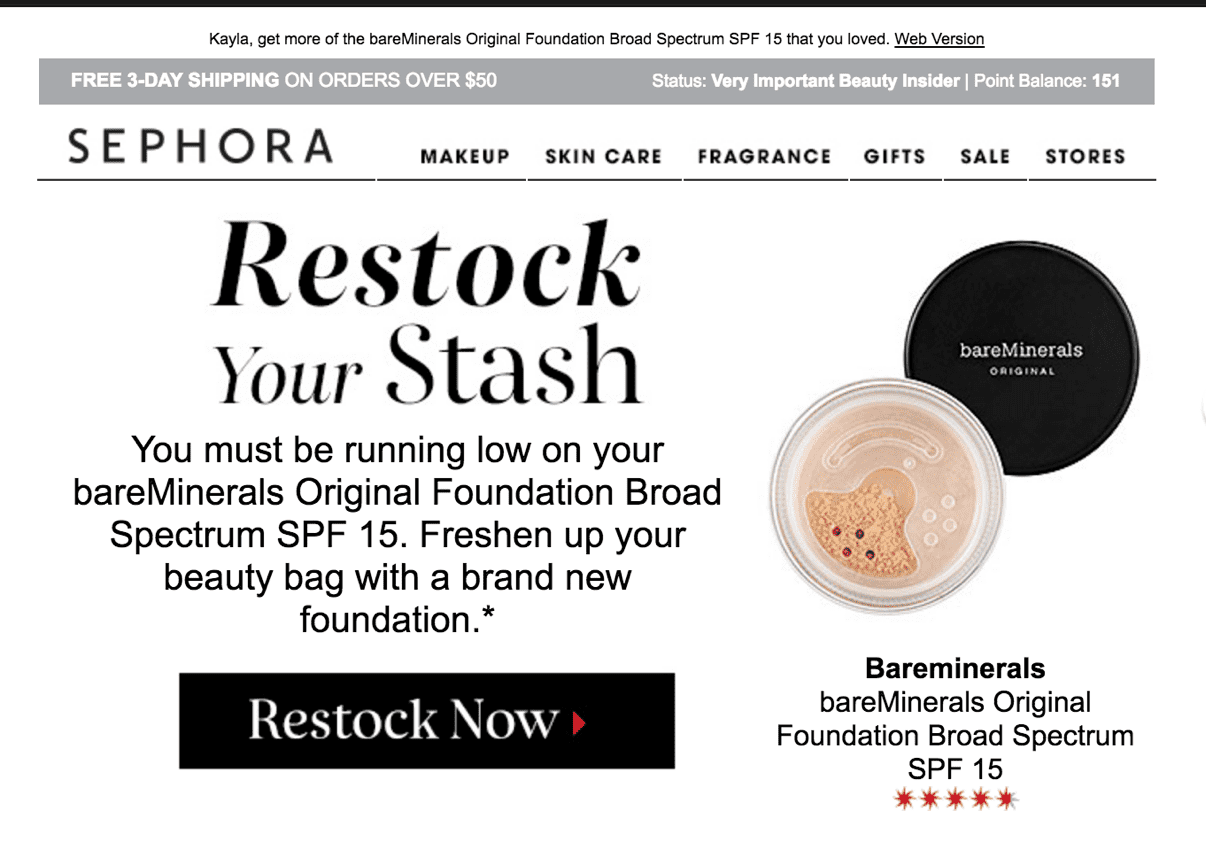
To learn more about email targeting and retargeting, you can also check out my podcast conversation with Adam Robinson, Co-Founder and CEO of GetEmails, (Now Retention.com).
3. Strong Focus on Conversions
A strong email marketing funnel must be designed for conversions. Every element of your emails should be optimized to lead recipients toward your desired goal. This includes things like effective calls-to-action, compelling visuals, and persuasive copy.
Here is an example:
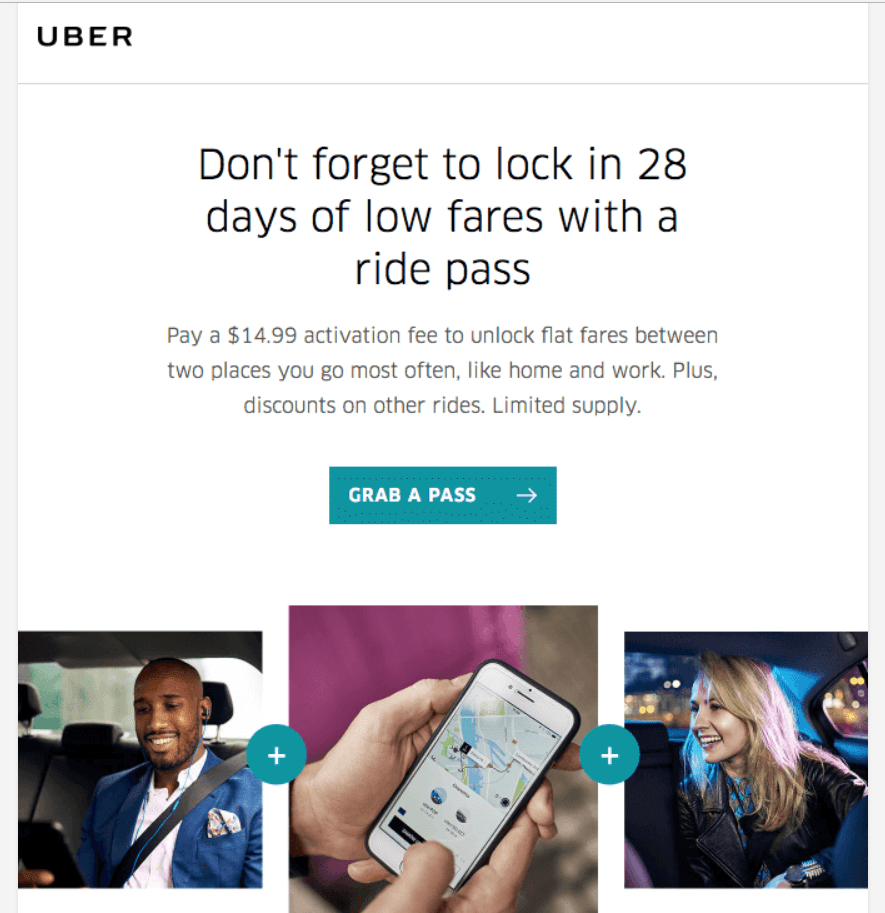
By focusing on conversion from start to finish, you'll be much more likely to achieve success with your email marketing campaigns.
4. Constant Improvement
To build an effective email marketing funnel, you need to continually test and optimize your funnel. You should constantly be testing different elements of your funnel to see what works best.
This could include testing different email subject lines, calls-to-action, or email content. By constantly testing and optimizing your funnel, you’ll be able to improve your results and increase your conversion rate.
How to Create An Email Marketing Funnel
Are you ready to build an email marketing funnel?
If you're not sure where to start, or if you're feeling overwhelmed by the process, don't worry. We've got you covered. In this section, we'll walk you through everything you need to know about building an email marketing funnel.
1. Set Specific Goals
Setting clear goals is essential to building an effective email marketing funnel. Without a goal, it's difficult to determine what steps need to be taken to achieve success. Additionally, having a goal gives you something to measure your progress against, so you can adjust your strategy as needed.
There are a few different ways to approach setting goals for your email marketing funnel.
First, you need to decide what metric you want to optimize for. This could be things like conversion rate, open rate, click-through rate, or any other number that's important to your business.
Once you have a metric in mind, set a specific target that you want to hit. For example, if you're trying to increase conversion rates, you might set a goal of 10%.
2. Create Target Personas
If you're looking to build an email marketing funnel, it's important to create multiple target personas. This will help you segment your audience and create targeted content that resonates with each group.
To do this, start by identifying the different types of people who would be interested in your product or service. Then, create a profile for each persona, including their demographics, interests, and pain points.
Here is an example of a sample persona profile:
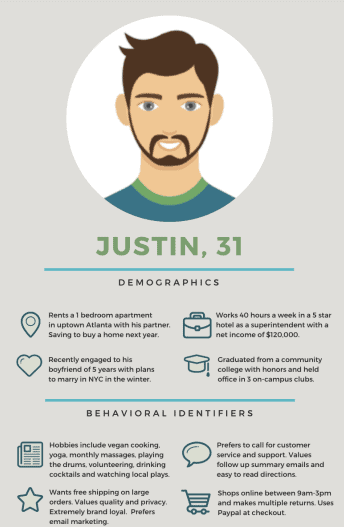
Once you have your target personas defined, you can start creating email campaigns that are specifically tailored to them. This will help you convert more leads into customers and grow your business.
3. Create a Lead Magnet
By offering something of value in exchange for an email address, you can encourage prospects to sign up for your mailing list and start receiving your marketing messages.
There are many different types of lead magnets you can create, but some of the most popular include ebooks, checklists, and templates.
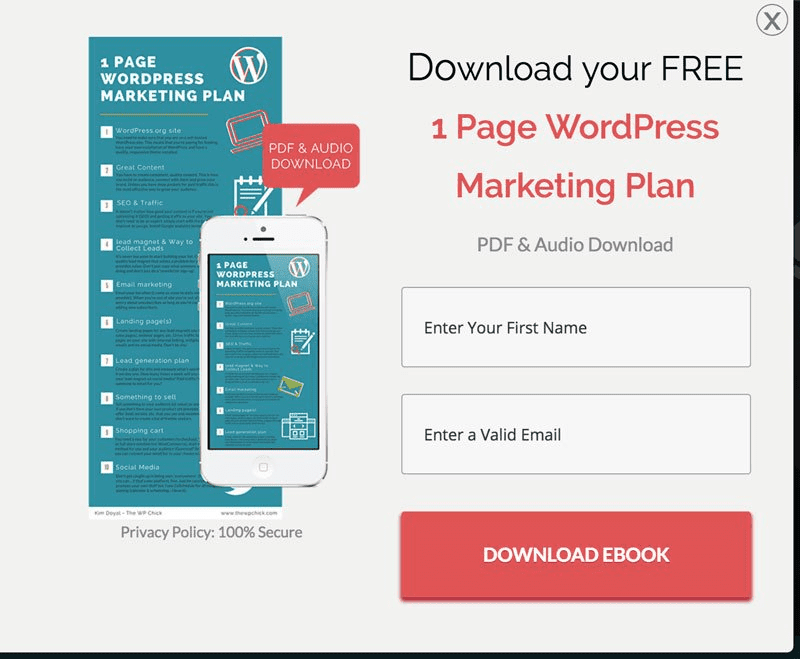
To get started, choose the type of lead magnet most valuable to your target audience and then create content that delivers on that promise.
Once you have your lead magnet made, the next step is to promote it through your website and social media channels. Be sure to include a relevant call-to-action (CTA) button that gets you more leads.
When promoting your lead magnet, it's also important to make sure you're providing value upfront. For example, if you're offering a template, be sure to mention what it includes so people can see what they'll be getting before they sign up.
This will help increase the opt-in rate and ensure that only people who are truly interested in your offer sign up for your list.
4. Build and Segment Your Email List
One of the most important aspects of any email marketing campaign is building and segmenting your email list. By segmenting your list, you can more effectively target your audience and create a more personalized experience for them.
There are a few different ways that you can segment your email list. You can add segmentation based on certain factors like:
- Location: This can be helpful if you have a physical product that you ship to different parts of the world. By segmenting your list by location, you can ensure that everyone on your list receives the right information for their region.
- Interests: This can be helpful if you have a diverse product line or offer different services. By segmenting your list by interests, you can send targeted content to those who are most likely to be interested in it. Additionally, this can help you create a more personalized experience for your subscribers.
- Purchase History: By segmenting your list by purchase history, you can send them targeted content that is relevant to their interests and needs.
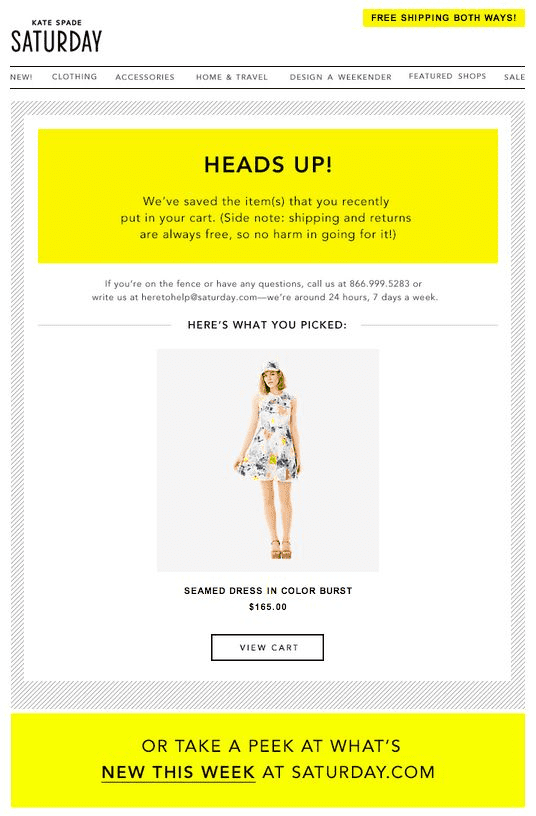
5. Create Email Content
Now that you have a list of subscribers, it's time to start creating email content. Your emails should be persuasive and engaging. They should also include a call-to-action (CTA) so that your subscribers know what to do next.
Once you've created your email content, it's time to send it out to your subscribers. You can do this manually, or use an email marketing service. I’ll share the best ones in the next section.
Once you are done with the content, it’s time to start sending it out and nurturing your leads. Keep in mind that consistency is key. So, make sure you send follow-up emails to each subscriber at regular intervals.
6. Analyze Your Results
If you want to create an effective email marketing funnel, you need to first analyze your performance. Without understanding how your past campaigns have performed, it'll be difficult to improve your results moving forward.
First, take a look at your email open rates. If your open rates are low, it could be due to a number of factors, such as an unengaging subject line or poor email list quality.
Next, look at your click-through rates. If your click-through rates are low, it could be because your emails are not relevant to your audience or they're not properly segmented.
Finally, look at your conversion rates. If your conversion rates are low, it could be because you're not sending targeted traffic to your landing pages or you're not offering a compelling incentive.
By analyzing your performance, you can identify where your email marketing funnel needs improvement. From there, you can make the necessary changes to improve your results moving forward.
Top Email Marketing Funnel Software
There are a few key automation software programs that you'll need in order to build an effective email marketing funnel. Here's a quick rundown of some of the most important ones:
1. Aweber
With Aweber, you can easily create opt-in forms to collect email addresses from your website visitors. Then, you can use those email addresses to send targeted emails that promote your products or services.
Aweber makes it easy to create beautiful email newsletters, too. So even if you're not a designer, you can still create professional-looking emails that will engage your subscribers.
Plus, Aweber integrates with all the major email service providers, so you can easily send your messages to your list of subscribers no matter where they are.
2. GetResponse
GetResponse makes it easy to create beautiful email campaigns that are tailored to your specific target audience. With GetResponse, you can easily add images, videos, and other rich media to your email campaigns to make them more engaging.
And, with GetResponse's advanced tracking and reporting features, you can track the performance of your email campaigns and optimize them for better results.
I’ve also written a separate post on GetResponse as a lead generation tool. Check it out to learn how to make the most out of the platform.
3. Brevo (formerly Sendinblue)
With Brevo, you can create beautiful email campaigns that are highly customizable and easy to use. Plus, Sendinblue offers powerful tools for segmenting your list, tracking your results, and optimizing your campaigns for better performance.
The best part is that this email marketing platform offers a free plan that allows you to send up to 300 emails per day.
Ready to Create Your Own Email Marketing Funnel?
There are a lot of moving parts when it comes to creating an email marketing funnel, but if you take the time to put everything in place, you'll be rewarded with a powerful tool for growing your business.
By clearly defining your target audience and mapping out the steps they'll take from first contact to conversion, you can create a funnel that will guide them through the process and keep them moving toward your goal.
With a little planning and execution, you can create an email marketing funnel that will get you more conversions and sales. I hope this post helped you understand how to go about creating your own email marketing funnel.
Do you have any questions related to creating your email marketing funnel? Please mention them in the comments section below. I’ll be happy to answer them for you.


Related Articles
33 Best Email Marketing Automation Tools to Grow Your Business
What is Email Marketing Automation?
21 Best Email Marketing Tools for 2024
31 Examples of Email Marketing Campaigns Done Right
15 Best Email Tracking Software Programs For Your Business
11 Best Free Email Template Builders to Improve Your Email Marketing